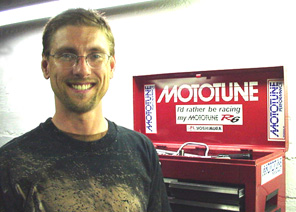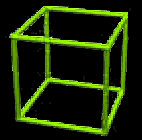
![]()
" Today, I'm Going to
Talk About The Super Sonic Nozzle "

Presents:


|
|
|
| Hi MotoMan, The other day I started working on another cylinder head for my car that I occasionally drag race here in Antigua, and I had started the porting on the inlets. I'd match ported the manifold to the head and hesitated. Looking at the last head I'd done, I realized that opening everything up to the max had plainly worked against me. With dual twin weber 45's on the previous build, I'd lost 2 seconds in the quarter mile from high 14's to mid 16's. I just thought I'd thank you for the kick in the ass wake-up factor. The port size and velocity of mix had been haunting me since last September and I was really beginning to feel that I was wrong in my assumption, as everybody around me was feeding me masses of other solutions. I look forward to campaigning the car later this year and, believe me, you'll be among the first to hear confirmation of your porting thoughts. Wonderful site. Alistair Hi Alistair ! I originally got the idea of making smaller ports on motorcycle engines from reading car magazines from the mid 1980's. They didn't specifically say that smaller ports were better, just that "sometimes" bigger ports weren't so good... So, I just "thought out of the box" and decided to try smaller ports. They work !! The reason more people haven't done it has more to do "the box" than logic or evidence. ~MotoMan |
|
| Hi MotoMan! I came across your engine break- in procedure link on the bulletin board for my car (Toyota MR2).. after I read that, I proceeded to do no work the rest of the morning and read all of the articles. Thanks for the good info! It just so happens that my engine, the 4AGE, originally came in what is now called the "large port", and later went to higher compression and smaller ports in the "small port" version. Some folks do the swap for the increase in HP, but I'm thinking I would just like to use JB Weld and shave the head a bit for the compression. I was wondering if you have an opinion on the idea of JB Weld and aluminum expanding at different rates. Thanks! -- Adrian Hi Adrian ! You just brought up a great point that I'll be getting to in this issue -- ( Do manufacturers know about small ports ?? ) The reason I use JB Weld is that it matches the expansion of aluminum and cast iron perfectly. Actually the more expensive "aluminum" epoxies I first tested in 1991 cracked and came loose !! Since I first started using JB Weld in 1992, I've never had any come loose. The main thing is to get the port completely clean & oil free, and that the thickest point of the epoxy is at least .080" / 2mm thick. This won't be a problem, since on most heads it will be around 7-8 mm thick. ~MotoMan |
|
In 1994 I had a conversation with 3 guys from an engineering college that
were in the Formula SAE competition. This is a
contest in which the students build a race car using a motorcycle engine,
and then compete against teams from
Back To The
Engineering Students Check things out for
yourself !!
|
Despite all the logic
& overwhelming
race victories, why is the idea of smaller ports still
so hard to accept ??
Once again, it has absolutely nothing to do with
reality,
it's all about "the box" !!
Here are some thoughts about small ports:
1)
It seems to
good to be true.
(Cynicism is fear.)
2) Some people who have always thought "bigger
is better" will find it hard to do the opposite, because it implies that their way was wrong.
(We're told all our lives
that wrong = failure, and that failure is to be feared
at all costs.)
3)
The idea of smaller ports begs the question: why
wouldn't the manufacturers
make the ports smaller in the first place ???
(It's scary
to think that "experts" would suppress knowledge & technology.)
4)
Smaller ports
are all about the net gain in flow, rather than the instant
satisfaction that
comes from seeing a "flowbench" gain.
(The idea of giving up instant gratification now, for a much bigger gain later is
a scary concept.)
5)
It would have been published in the mainstream
textbooks
& magazines.
(It's scary to think that the media
doesn't have knowledge of all things, or that they don't always tell the truth.)
6)
For some people it's simply a matter
of:
" That's not the way everyone else does it "
(Most people find it impossible to think differently than
others, out of fear
of being ridiculed.)
That's right ...
Fear
makes up the 6 sides of this type of "box"

Q: Who makes the "Box" ???
A: We build it ourselves, gradually over the course of a
lifetime.
Once he becomes aware that the box exists, every man must make a conscious
choice to stay in it.
Therefore, every man is also equally free to escape from it.
Hey ... I just thought of a funny new way to say "Think Out of The Box" :
|
|
Don't Get Sucked Into The m |
What's one of the best ways
to escape the
powerful
'thinking vacuum' created by the SuperSonicNozzle
???
Hi Velocity Port Your Own
Cylinder Head !!!
By doing it yourself, you'll not only
get more power for your engine, you'll also refuse to accept "the box"
!!
ARTWORK
|
|
|
You say you're not an artist ?? |
|
|
|
Gravity will naturally level the epoxy. Since the roof
of the port slopes down at a constant angle, the epoxy floor
"automatically" makes the correct |
|
|
Next, match the epoxy near the valve bowl to the
existing circle created by the valve seat. Don't enlarge the opening, just
match it, and you'll get a perfectly shaped valve pocket. |
|
|
Once the choke point height is set, then sand the radius
smooth as described in the past issues... |
|
|
You are now hereby officially
qualified to High Velocity port your head !! |
The Bandwagon
I've seen lots of discussion forums & chat rooms discussing the latest Power
News articles. Many people are asking the others: what do you think of smaller
ports ??
What if I told you that the best tuners, producing the fastest engines at the
highest levels of world competition used this technique ???
or
What if I didn't say that ??
Does it change the logic of the last 3 issues of Power News ??
Who cares what everyone else thinks ...
what do you think ???
It's a fact that most people want to be on the popular side.
If it seems like "most people"
support an idea, then the vast majority of
people will find it safe to jump on the bandwagon
in spite of the truth or falseness of
the idea.
Plenty of "bandwagon" riders have fallen off the cliff and crashed.
The
" human nature " of the bandwagon effect is a serious liability to
logical thinking.
|
Power News
isn't about the bandwagon. |
Getting off the bandwagon ride gives you a new kind of power ... don't you agree ??
Do the manufacturers know about high
velocity ports ???
Of course they do.
m

Many of the magazine new model shootouts and reviews are subjective and offer
few
deep insights into how engine performance is actually improved from year to
year. But if you're
reading carefully you can sometimes "connect the dots" about smaller
ports !!
Here are 2 examples that come to mind:
1995 CBR 600f3 "Intake porting changes" are one of the listed
improvements from the previous f2
1998 R1 "the valves are 1mm smaller than the previous FZR1000 Thunder
Ace."
Both models were clearly better than their predecessors, and both made use
of
higher velocity (smaller) intake ports !!
Introduction To Exhaust Porting:
Here's more evidence
of the difference between what is commonly thought and what is actually true.
|
|
|
|
"MotoMan"
Has A Brief Conversation With |
|
Stay Tuned !!
Exhaust Porting Part 2 ...
... in the next action packed issue of Power News !!!
|
Learn How to Do it Yourself:
Smaller Intake Ports Gain 7 % More Power
|